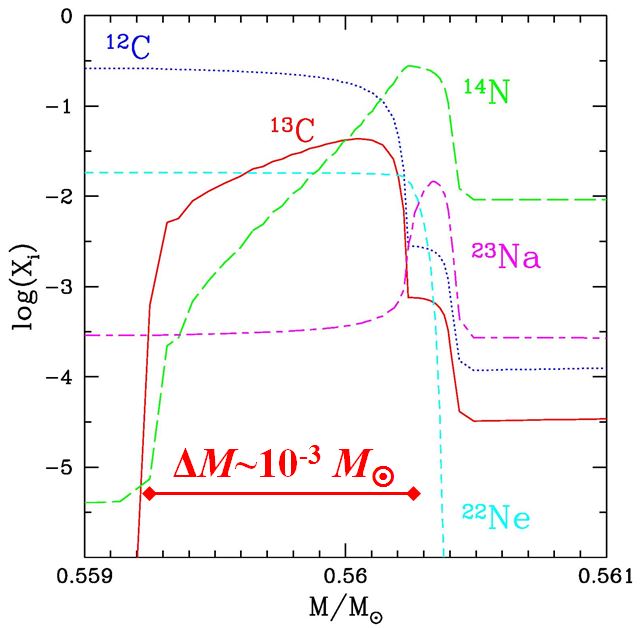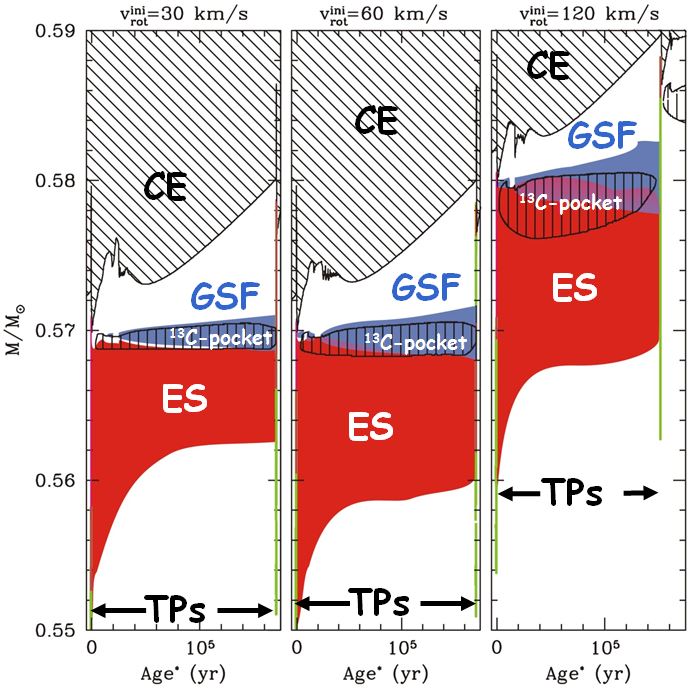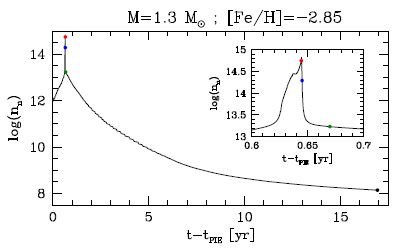
Do you know where iron in your blood, calcium and carbonium in your bones, fluorine in your teeth,
nitrogen you are breathing are from? Or what is the origine of common elements such as aluminum,
nickel, gold, silver, chromium and lead?
The element abundances in the Solar System are due to the mixing of material ejected from
stars that polluted the Universe in different epochs before the Sun formation, occurred about
5 billion years ago, after the gravitational contraction of the proto-solar cloud.
All isotopes have been synthetized in stars, with the exception of the light elements present in the Universe after the big-bang nucleosynthesis
(H, He, Li).
Some elements formed during quiescent idrostatic evolutionary phases; other elements have been produced during late
evolutionary stages of massive stars; finally, some isotopes originated during a particular phase called
Asymptotic Giant Branch (AGB stars).
There's no way to explain solar abundances of isotopes heavier than iron (A>56) through nuclear reaction involving
charged particles, because cross sections rapidly decrease by increasing the charge Z: this is mainly due
to the Coulomb effect. Moreover, iron is characterized by the maximum binding energy per nucleon, causing thermonuclear
processes starting from iron seeds to be endoenergetic.
Limitations due to the Coulomb barrier are not present for neutron captures. The observed heavy elements distribution
shows the presence of two dinstinct components (we are at the moment neglecting the p component), correlated to
different nucleosynthetic processes:
![]()
The r process requires very high neutronic densities and it's believed to occur during final phases of massive stars (SuperNovae) and/or during the merging of compact objects
(X-rays binaries).
The s process is characterized by a slow neutron capture with respect the corresponding
β decay:
stable isotopes capture neutrons, while radiactive isotopes decay (β- or
β+) or capture a free electron.
These isotopes are mainly created in the TP-AGB (Thermally Pulsing Asymptotic Giant Branch) phase
of low mass stars (1.5 < M / Msun < 3); freshly synthetized elements are carried out to the
surface by means of a recurrent mechanism called TDU (Third Dredge Up).
In this phase, the stellar structure constists of a partially degenerate carbon-oxigen core, an He shell and an H shell separated by an He-intershell,
and a convective envelope. The energy required to supply the surface irradiation is mainly provided by the shell H burning,
located just below the inner border of the convective envelope. The H shell burning is recurrently interrupted by a series
of thermonuclear runaways driven by violent He ignitions.
As a consequence of a TP (Thermal Pulse), the region between the two shells (He-intershell) becomes unstable to convection
for a short period, the external layers expand and, later on, the H shell burning temporarily dies down. At this point, the convective evelope can penetrate the underlying
layers, carrying to the surface the freshly synthesized products (TDU episode).
In the He-intershell, He is partially converted to carbon.
During the AGB phase, main neutron sources are:
 While 22Ne is synthetized in the pulse by the sequence
14N(α,γ)18O(α,γ)22Ne, in order to obtain a large enough 13C enriched layer (the so-called 13C pocket)
we need to introduce a mechanism allowing
the proton diffusion from the H-rich envelope into the C-rich radiative zone below the inner border of the convective envelope.
The introduction of an exponentially decaying profile of velocity below the convective envelope allows a small amount of
protons to diffuse into the He and C-rich zone, leading to the formation of a 13C pocket layer, whose extension
varies from pulse to pulse (the study of the effects of the introdution of this algorithm has been discussed in my degree thesis).
Our 13C pocket is partially overlapped to a 14N pocket, which acts as a strong neutron poison for the s-process.
Once obtained the 13C, next step has been the construction of a complete nuclear network in order to follow in detail
all nucleosynthetic processes occurring in an AGB star, by using cross section upgraded with the most recent
esperimental values (if available) or new theoretical determinations (such a work has been done during first two years
of my Phd in Computational Astrophysics).
In the FUNS code, a full set of equations describing the physical evolution of a star is coupled with the nuclear processes
fixing the temporal variation of the nuclear species: as a consequence we are able to determine from the theoretical point
of view the s-process paths and yelds in AGB stars without recurring to any post-process techniques. All the computed models are available of the
FRUITY
While 22Ne is synthetized in the pulse by the sequence
14N(α,γ)18O(α,γ)22Ne, in order to obtain a large enough 13C enriched layer (the so-called 13C pocket)
we need to introduce a mechanism allowing
the proton diffusion from the H-rich envelope into the C-rich radiative zone below the inner border of the convective envelope.
The introduction of an exponentially decaying profile of velocity below the convective envelope allows a small amount of
protons to diffuse into the He and C-rich zone, leading to the formation of a 13C pocket layer, whose extension
varies from pulse to pulse (the study of the effects of the introdution of this algorithm has been discussed in my degree thesis).
Our 13C pocket is partially overlapped to a 14N pocket, which acts as a strong neutron poison for the s-process.
Once obtained the 13C, next step has been the construction of a complete nuclear network in order to follow in detail
all nucleosynthetic processes occurring in an AGB star, by using cross section upgraded with the most recent
esperimental values (if available) or new theoretical determinations (such a work has been done during first two years
of my Phd in Computational Astrophysics).
In the FUNS code, a full set of equations describing the physical evolution of a star is coupled with the nuclear processes
fixing the temporal variation of the nuclear species: as a consequence we are able to determine from the theoretical point
of view the s-process paths and yelds in AGB stars without recurring to any post-process techniques. All the computed models are available of the
FRUITY
 (FUNS Repository of Updated Isotopi Tables and Yields) database web-pages. Up to date, FRUITY is the largest worldwide homogeneous
AGB database, providing both physical and chemical quantities for stars spanning a wide range of initial masses (from 1.3 to 6.0 Msun) and
metallicities (from [Fe/H]=-2.85 to [Fe/H]=+0.15). Models can be freely downloaded, preserving the anonimity of researchers/users.
(FUNS Repository of Updated Isotopi Tables and Yields) database web-pages. Up to date, FRUITY is the largest worldwide homogeneous
AGB database, providing both physical and chemical quantities for stars spanning a wide range of initial masses (from 1.3 to 6.0 Msun) and
metallicities (from [Fe/H]=-2.85 to [Fe/H]=+0.15). Models can be freely downloaded, preserving the anonimity of researchers/users.
The FRUITY database also contains rotating models. Rotation induced instabilities may modify the on-going s-process nucleosynthesis, with important consequences on the final surface s-process distributions. We find that the Goldreich–Schubert–Fricke (GSF) instability, active at the interface between the convective envelope and the rapid rotating core, contaminates the 13C pocket with 14N, thus reducing the neutron flux available for the synthesis of heavy elements. As a consequence, the yields of heavy-s elements (Ba, La, Nd, Sm) and, to a lesser extent, those of light-s elements (Sr, Y, Zr) decrease with increasing rotation velocities. However, for larger initial rotation velocities, the production of light-s and, to a lesser extent, that of heavy-s, begins again to increase, due to mixing induced by meridional circulations (Eddington-Sweet instability, ES). At low metallicity, the effects of meridional circulations are important even at rather low rotation velocity. The combined effect of the Goldreich–Schubert–Fricke instability and meridional circulations determines an increase of light-s and, to a lesser extent, heavy-s elements, while lead is strongly reduced. Our analysis suggests that rotation could partly explain the spread in the s-process indexes, as observed in s-process enriched stars at different metallicities.
Our reference theoretical FRUITY set, however, fits only part of the observations.
 At [Fe/H]>-1, a good fit is found when rotation is taken into account.
Notwithstanding, our theoretical models are unable to attain the large [hs/ls] ratios characterizing the surfaces of very metal poor stars, the so-called
Carbon Enhanced Metal Poor (CEMP) stars.
Interestingly, at very low metallicities, due to the reduced entropy barrier of the H-burning shell, it may happen that during the development of
a TP, protons from the above H-rich layers can be engulfed in the convective shell. This implies an on-flight burning of hydrogen at very high temperatures, with a
large production of 13C and a consequent s-process nucleosynthesis. We refer to this episode as PIE (Proton Ingestion Episode).
The modelling of this ingestion is, however, very tricky, in particular when dealing with 1D hydrostatic codes. In our models, we attain
very large neutron densities (of the order of 1015 neutrons cm-3) for a limited period.
However, the following evolution practically erases any trace of this non-canonical nucleosynthesis, thus strongly reducing the possibility
that the large [hs/ls] ratios observed in CEMPs could be related to the occurrence of PIEs.
At [Fe/H]>-1, a good fit is found when rotation is taken into account.
Notwithstanding, our theoretical models are unable to attain the large [hs/ls] ratios characterizing the surfaces of very metal poor stars, the so-called
Carbon Enhanced Metal Poor (CEMP) stars.
Interestingly, at very low metallicities, due to the reduced entropy barrier of the H-burning shell, it may happen that during the development of
a TP, protons from the above H-rich layers can be engulfed in the convective shell. This implies an on-flight burning of hydrogen at very high temperatures, with a
large production of 13C and a consequent s-process nucleosynthesis. We refer to this episode as PIE (Proton Ingestion Episode).
The modelling of this ingestion is, however, very tricky, in particular when dealing with 1D hydrostatic codes. In our models, we attain
very large neutron densities (of the order of 1015 neutrons cm-3) for a limited period.
However, the following evolution practically erases any trace of this non-canonical nucleosynthesis, thus strongly reducing the possibility
that the large [hs/ls] ratios observed in CEMPs could be related to the occurrence of PIEs.